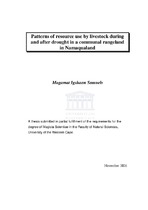| dc.contributor.advisor | Allsop, Nicky | |
| dc.contributor.author | Samuels, Mogamat Igshaan | |
| dc.contributor.other | | |
| dc.contributor.other | Faculty of Science | |
| dc.date.accessioned | 2013-09-10T12:53:32Z | |
| dc.date.available | 2008/04/24 14:22 | |
| dc.date.available | 2008/04/24 | |
| dc.date.available | 2013-09-10T12:53:32Z | |
| dc.date.issued | 2006 | |
| dc.identifier.uri | http://hdl.handle.net/11394/2044 | |
| dc.description | Magister Scientiae - MSc | en_US |
| dc.description.abstract | Pastoralists in Africa have developed complex mechanisms by which they can alleviate the threat of drought. They practice mobility as one of the strategies to avoid the worst effects of natural stress and disperse grazing pressure. In the past in South Africa, the indigenous Nama people occupied large areas of land and moved around extensively to exploit seasonal differences in the availability of forage and water. With the settlement of the Europeans in the Cape the indigenous people lost most of their land to the colonists. The Nama people were, therefore, restricted to smaller rangelands and their patterns of rangeland use had to adapt to the spatial constraints. Descendants now herd livestock from semi-permanent stockposts that are scattered throughout the commons. Herders use a range of practices to manage their livestock. The aims of this study was to assess the agro-ecological knowledge of livestock keepers; assess the condition of the rangeland during drought; determine the herding strategies of herders during drought. | en_US |
| dc.language.iso | en | en_US |
| dc.publisher | University of the Western Cape | en_US |
| dc.subject | Rangelands | en_US |
| dc.subject | Monitoring | en_US |
| dc.subject | South Africa | en_US |
| dc.subject | Namaqualand | en_US |
| dc.subject | Grazing | en_US |
| dc.subject | Management | en_US |
| dc.subject | Cattle herding | en_US |
| dc.title | Patterns of resource use by livestock during and after drought in a communal rangeland in Namaqualand | en_US |
| dc.type | Thesis | en_US |
| dc.rights.holder | University of the Western Cape | en_US |
| dc.description.country | South Africa | |

